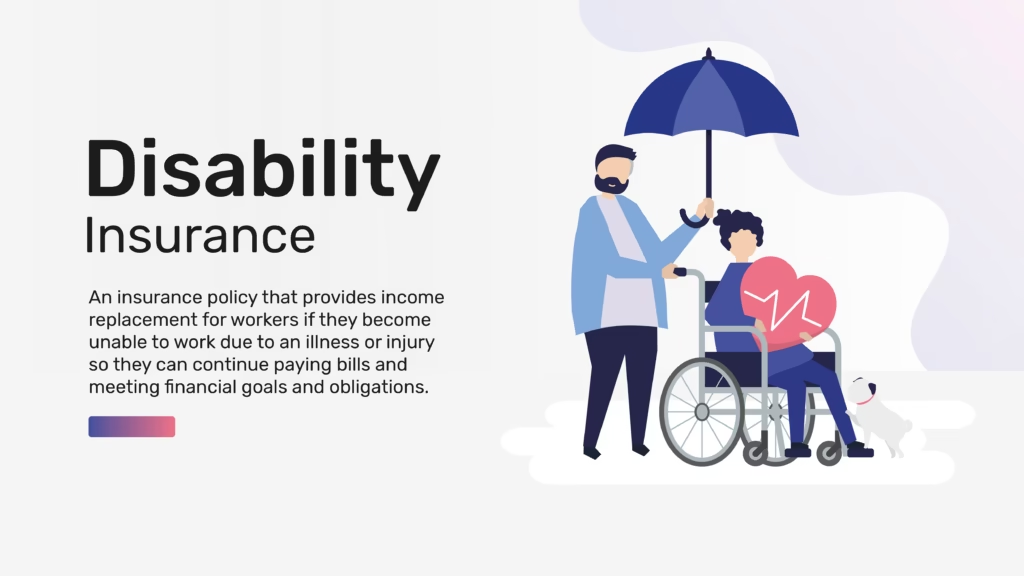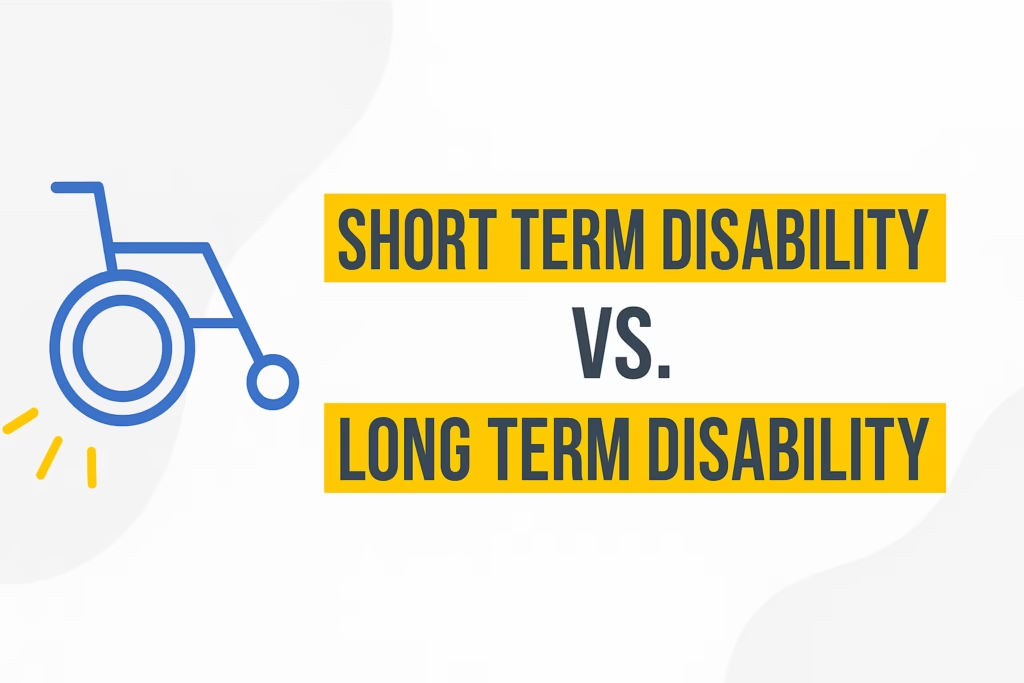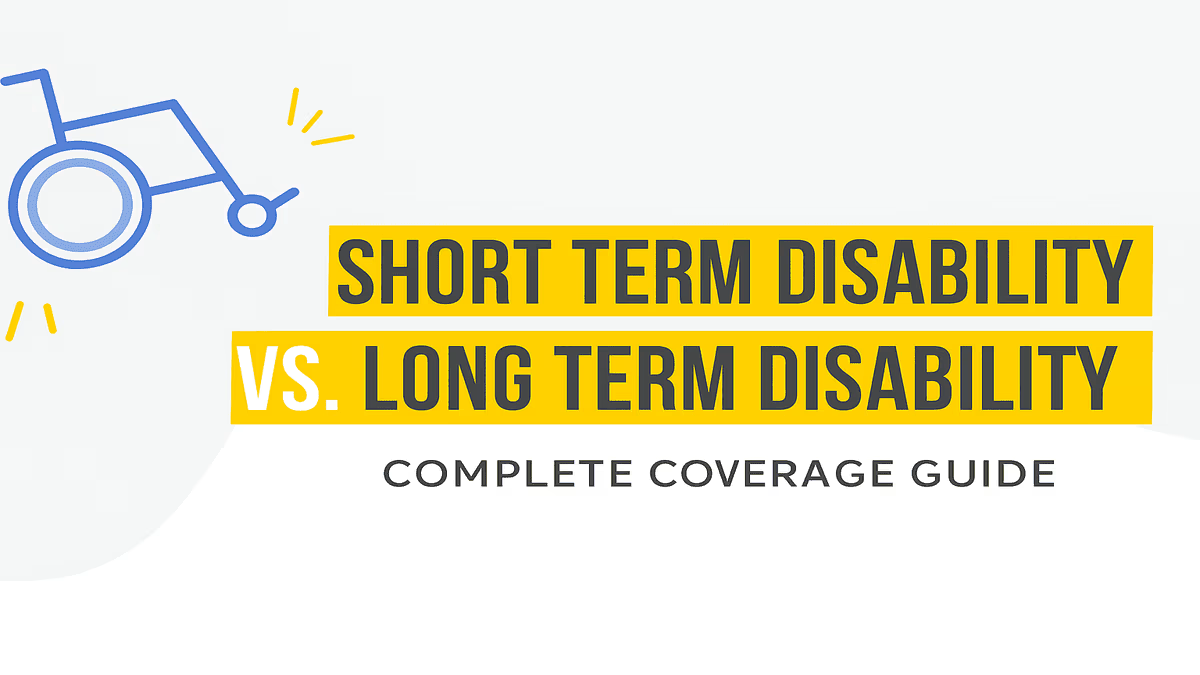Life has a way of throwing unexpected challenges our way and when illness or injury strikes, the financial burden can be overwhelming. Imagine being unable to work for months or even years because of a medical condition- how would you maintain your lifestyle and provide for your family? This sobering reality impacts more people than you might think according to the Social Security Administration, more than one in four 20-year-olds today will suffer from a disability that lasts at least one year before they reach the age of retirement. It’s important to know short term disability vs long term disability insurance’s important differences to help you manage your financial future.
Disability insurance is an essential safety net, providing a portion of your income if you’re unable to work due to medical needs. However, we will also know what medical conditions qualify for long-term disability and the landscape of temporary disability benefits and permanent disability insurance options may seem complex. In this comprehensive guide, we’ll explore the key differences between these two types of disability insurance, understand the duration of coverage, benefit payments, and provide actionable insights to help you make an informed decision about safeguarding your most precious asset: your earning potential.
What is Short Term Disability Insurance?
Short term disability insurance provides short-term coverage for when you can’t work because of illness, injury, or medical conditions that keep you from performing the job. This type of coverage generally becomes active after a short waiting period and provides income-paying benefits for a set period of time.
According to the Bureau of Labor Statistics, roughly 40% of private industry workers have short-term disability benefits offered by their employers. This coverage acts as a vital bridge during the initial months of a disability, maintaining financial stability while you concentrate on healing.
Key Features of Short-Term Disability Coverage
Short term disability coverage typically has a few key features that make it different from other types of disability insurance:
Speedy Activation of Benefits: Usually 0-14 days waiting period; Higher Income Replacement: Usually 60-80% of pre-disability income; Weekly Benefit Limits: Maximum weekly benefits range from $1,000-$2,500; Limited Term: Coverage usually lasts 3-12 months; Comprehensive Medical Coverage: Covers pregnancy, surgery recovery and acute illnesses.
The amount of benefits received is usually 60-80% of your pre-disability income (although some policies have higher rates). Also, the maximum amount of benefits per week is often limited to a certain dollar amount that varies both by policy and employer. Additionally, short term disability benefits are intended to cover the gap between the occurrence of disability and your return to work or the commencement of long-term disability benefits.
How Long Does Short Term Disability Last?
Knowing how long does short term disability lasts is essential when assessing your insurance needs. Most short-term disability policies offer three to twelve months of coverage, with six months being the most common length of time. However, there are policies that can provide up to two years of benefits, depending on the conditions and terms of the policy.
Real-World Example: Sarah, a marketing manager, undergoes a major operation that includes a 4-month recovery phase. Her short-term disability policy with a 7 day elimination period and 6 months maximum benefit period, would pay $800 per week ($70% of her $1,200 per week salary) beginning on day 8 of her leave, giving her enough money to live on during her recovery period.
What is Long Term Disability Insurance?
Long term disability coverage extends the income protection to disabilities that last longer than the short-term disability coverage period. Permanent disability insurance is a form of disability insurance that’s designed to pay a percentage of your salary when you’re unable to work for a long period of time or permanently.
In addition, data from the Council for Disability Awareness shows that the average duration of a long-term disability claim is 34.6 months, making extended coverage an absolute necessity. Additionally, 5% of working Americans will have a long-term disability each year, making this protection an important part of comprehensive financial planning.
Understanding Long Term Disability Coverage
Long-term disability coverage usually starts immediately after short-term disability ends, although some policies can begin to pay immediately after a longer elimination period. The elimination period for long-term disability generally lasts from 90 days to one year, with the most common period being 90 to 180 days. The waiting period is there for the purpose of making sure that only truly permanent disabilities trigger benefits.
Key Components of Long-Term Disability Coverage:
Occupation Definitions: “Own occupation” vs. “any occupation” coverage Benefit Periods: 2 years to age 65 or lifetime Income Replacement: 50-70% of pre-disability earnings Cost of Living Adjustments: Increases in benefits paid annually to offset inflation
Residual Benefits: Benefits paid for partial disability
In addition, long-term disability policies often have more inclusive definitions of coverage. Most policies cover you during the first benefit period with “own occupation” coverage; that is, you’re considered disabled if you can’t perform the duties of your particular job. After a certain time, usually two years, the definition can change to “any occupation” and you’ll have to be unable to work in any occupation for which you’re reasonably qualified.
How Long Does Long Term Disability Last?
The length of long-term disability benefits depends heavily on your policy terms. Coverage can range from two years up to age of 65, retirement age or life depending on the policy provisions. Most employer-provided long-term disability policies pay until age 65, the traditional retirement age.
Case Study: Michael, age 35, an engineer, develops multiple sclerosis that prevents him from working His long-term disability policy will pay out $4,000 a month (60% of his $80,000 annual salary) until age 65 for a total of about $1.44 million in lifetime benefits – proving the immense value of long-term coverage.
Short Term Disability vs Long Term Disability: Comprehensive Comparison
| Feature | Short Term Disability | Long Term Disability |
| Elimination Period | 0-14 days | 90-365 days |
| Benefit Duration | 3-12 months | 2 years to age 65+ |
| Income Replacement | 60-80% | 50-70% |
| Average Premium Cost | $25-$75/month | $150-$400/month |
| Tax Treatment | Often taxable | Usually tax-free (individual policies) |
| Portability | Limited | High (individual policies) |
| Medical Requirements | Basic | Comprehensive |
Coverage Duration and Timing
The first and most obvious difference is that of the coverage period. Short term disability covers a period of weeks to months, whilst long term disability covers a period of years or decades. Also, the elimination periods vary greatly – short-term disability often has very few waiting periods, while long-term disability benefits will usually require longer elimination periods before becoming eligible for coverage.
Benefit Amounts and Structures
Short term disability normally covers a higher percentage of your income (60-80%) but for a shorter period of time. Conversely, long term disability typically replaces a much lower percentage (50-70%) over a much longer period of time. In addition, long-term disability policies tend to include cost-of-living features to help ensure that benefits can be easily adjusted to retain their purchasing power over time, whereas short-term policies rarely include such features.
According to industry specialist John Patterson, CFP, of the National Association of Insurance and Financial Advisors: “The biggest mistake people make is thinking only in terms of short-term protection and neglecting to account for long term risks.” A disability of more than two years can ruin a family’s financial future if not insured with long term coverage.
Types of Disability Insurance: Employer vs Individual Coverage

It is also important to understand the various sources of disability insurance to ensure that you have comprehensive coverage and to identify any potential gaps in your protection.
Employer-Sponsored Disability Benefits
Many employers provide short term and long-term disability insurance as part of the benefits package. According to the Employee Benefit Research Institute, 39% of workers have access to short term disability through their employers and 33% have access to long term disability coverage.
Typical Employer Coverage Features: Group Rates Usually Less Than Individual Policies Limited Ability to Tailor Coverage Tied to Employment Status Benefits May Be Taxable Coverage Definitions Typically Basic
However, employer-sponsored coverage may have restrictions. As a rule of thumb, if the premiums are paid by the employer, the benefits are taxable, and this lowers your net benefit amount. Further, coverage usually stops when you leave your job, so you’re left without coverage when you transition between jobs.
Individual Disability Insurance Advantages
Individual disability insurance plans provide some benefits over employer-sponsored plans. These policies are portable, so you can take them with you from job to job. Benefits are usually tax-free when you pay premiums with after-tax money, to enhance your net income replacement
Premium Example A 30-year-old professional earning $75,000 per year would pay about $125 a month for a comprehensive individual long term disability policy that would pay $3,750 per month to age 65 – a meager 2% of their income for substantial protection.
SSI vs SSDI: Government Disability Programs
Government disability programs are another source of protection although how they are set up is different from private disability insurance.
Social Security Disability Insurance (SSDI)
SSDI pays benefits to people who have paid into Social Security and have become disabled. The program has a strict definition for disability – you must be unable to do any substantial gainful activity because of a medical condition that is expected to last at least 12 months or lead to death.
Critical Statistics: Only 35% of SSDI applications are approved on the first try
- Average monthly SSDI benefit is about $1,537 (2024)
- Median waiting time to approval is 7 months
- Benefits replace about 40% of your pre-disability income
Supplemental Security Income (SSI)
SSI offers benefits to disabled people with limited income and resources, regardless of work history. This categorical program has stringent financial eligibility requirements and benefits small benefit amounts. The maximum federal SSI benefit for 2024 is $943 per month for an individual, stressing the importance of additional private coverage.
Temporary Disability Benefits: State Programs
Several states have temporary disability insurance programs to cover short-term disability benefits for eligible employees.
State Disability Programs Overview
California, Hawaii, New Jersey, New York, and Rhode Island operate state disability programs that provide temporary disability benefits. These programs typically offer partial wage replacement for short term disabilities, funded through employee payroll deductions.
State Program Examples: California, Hawaii, New Jersey, New York, and Rhode Island have Temporary Disability Insurance (TDI) programs. These plans usually provide some wage replacement for short-term disability and are paid for by employees via payroll withdrawals. State Program Examples: New York DBL: Up to $170/week for up to 26 weeks California SDI: Up to $1,620/week for up to 52 weeks
- New Jersey TDB: Up to $1,009 a week for up to 26 weeks
Integration with Private Coverage
State disability programs often serve as a foundation for disability protection, with private insurance supplementing government benefits. Understanding how these programs interact with employer-sponsored and individual coverage maximizes your total disability protection without benefit overlaps.
Common Disability Scenarios and Coverage Examples
Scenario 1: Temporary Injury Recovery
Jennifer, a teacher, breaks her leg skiing and is off of work for 3 months. Her short term disability policy pays 70% replacement income ($700 per week) after a 14-day elimination period, which means that it pays her salary loss ($1000 per week) while she is recovering.
Scenario 2: Chronic Illness Management
An accountant, David is diagnosed with rheumatoid arthritis which gradually restricts his ability to work. Initially, he is given short term disability benefits for 6 months, after which he will continue to receive long term disability payments of $3,200 a month (60% of his $64,000 annual salary) until the age of 65.
Scenario 3: Mental Health Disability
Lisa is a software developer suffering from severe depression that requires long term treatment. Her own long-term disability policy includes a mental health benefit with a 2-year maximum for psychiatric conditions which provides essential income protection while she is out of work recovering.
Choosing the Right Disability Insurance Strategy
Developing an effective disability insurance strategy requires evaluating your specific needs, existing coverage, and financial goals.
Step-by-Step Coverage Assessment
- Calculate Monthly Expenses: List essential and discretionary spending
- Evaluate Existing Coverage: Review employer benefits and government programs
- Identify Coverage Gaps: Determine additional protection needed
- Compare Policy Options: Analyze individual vs group coverage
- Consider Future Needs: Account for income growth and life changes
Assessing Your Disability Insurance Needs
Begin by calculating your monthly expenses and figuring out how much income replacement you’ll require. Take into account not only basic needs like housing and utilities, but also discretionary spending. Also, consider medical expenses that may go up in a period of disability.
Income Replacement Rules: Essential expenses: 50-60% of current income Comfortably well off: 70-80% of current income Comprehensive coverage: 80-90% of current income
Most financial experts suggest you’ll need to replace 60-80% of your pre-disability income through a combination of disability insurance sources.
Coordinating Multiple Coverage Sources
The coordination of multiple sources of coverage is often a key part of disability protection. Short term disability can fill the gap in the time that long term disability begins, and Social Security and state programs offer further assistance. However, when you receive benefits from multiple sources, be aware of coordination of benefits provisions that may limit payments.
According to disability insurance specialist Maria Rodriguez, ChFC: “The best disability protection strategies stack multiple sources of coverage without over-insuring.” The aim is to provide forecast income coverage, which will reasonably respond to varying disability situations.
Common Misconceptions About Disability Insurance
Several misconceptions prevent people from adequately protecting themselves with disability insurance.
1. “It Won’t Happen to Me” Mentality
Many people underestimate their risk of disability. The reality is alarming: 90% of disabilities are due to illness, not accidents, and mental health conditions have covered 30% of disability claims, back injuries account for 20% of all disability claims, and cancer and heart disease combined are responsible for 15% of disabilities.
2. Overreliance on Workers’ Compensation
Workers’ compensation only protects job-related injuries and illness, resulting in major gaps in protection. Studies indicate that only 5 percent of disabling injuries are work-related while 95 percent of disabling injuries occur outside of the workplace and thus personal disability insurance is vital for comprehensive protection.
3. “Social Security Will Cover Me” Assumption
Most workers believe Social Security disability will offer enough protection. However, the average Social Security Disability Insurance (SSDI) benefit only replaces 40 percent of pre-disability income, and due to the stringent qualification requirements, 65 percent of initial applications are denied.
Maximizing Your Disability Insurance Benefits
There are several strategies you can use to maximize your disability insurance protection and ensure you’re getting the most benefits when you need them.
• Documentation Best Practices
Keep comprehensive medical records from all healthcare providers; records of functional limitations and work restrictions; documentation of compliance with treatment and treatment progress; written statements from physicians regarding work capacity; and preservation of employment records reflecting job requirements
• Understanding Policy Definitions
Carefully review the definition of disability in policies, as this has a big impact on eligibility for benefits. Own occupation coverage is usually better than any occupation coverage, particularly for highly skilled professionals.
Definition Comparison Example: A surgeon with “own occupation” coverage would be entitled to benefits if unable to perform surgery in spite of his ability to work as a doctor in other ways. Under any occupation, benefits may be denied if the surgeon was able to work in another medical capacity.
• Regular Policy Reviews
You should review your disability insurance coverage periodically to make sure it is keeping up with income increases and life changes. When you get promotions or salary increases, consider raising the coverage limits to ensure you have enough income replacement.
Financial Planning with Disability Insurance
Disability insurance should be part of your overall financial plan to provide you with comprehensive protection.
• Emergency Fund Considerations
While disability insurance can provide a source of long-term income replacement, an emergency reserve can be used to pay for the elimination period and unforeseen costs during the period of disability. A financial advisor will advise 3-6 months expenses in the form of savings that is readily accessible, and disability insurance will increase this to 6-12 months for added security.
• Retirement Planning Impact
Long-term disability can have a dramatic effect on retirement planning. Some disability policies offer to include retirement plan contributions as a part of the benefit calculation, to keep individuals on track for retirement even during disability.
Financial Impact Analysis: A 40-year-old earning $100,000 who becomes permanently disabled could lose out on $2.5 million in lifetime earnings if they don’t have the right long-term disability coverage, a testament to the enormous financial safeguards these policies offer.
Advanced Disability Insurance Strategies
Supplemental Coverage Options
Consider these additional coverage features to enhance your disability protection:
- Cost-Of-Life Adjustments (COLA): Annual benefit increase to keep up with inflation
- Residual Benefits: Partial benefits for partial disabilities
- Future Increase Options: Ability to increase coverage without medical underwriting
- Student Loan Protection: Specialized riders for educational debt obligations.
Industry-Specific Considerations
Different professions have different disability risks and need different coverage approaches:
- High-Risk Occupations: Construction workers, healthcare professionals, and manual laborers may need enhanced short term disability coverage due to higher injury rates.
- Professional Services: Attorneys, physicians, and consultants can enjoy strong “own occupation” long-term disability coverage that protects their specialized earning capacity.
- Technology Workers: Software developers and other IT professionals should be considering coverage for repetitive stress injuries or mental disorders that are common in high-pressure environments.
Disability Insurance Myths Debunked
Myth 1: “Young People Don’t Need Disability Insurance”
Reality: Fact: Rates of disability are actually higher among younger workers. According to the National Safety Council, workers ages 25-34 have 25% more disability claims than those ages 55-64 due to mental health conditions and accidents.
Myth 2: “Disability Insurance is Too Expensive”
Reality: Fact: Individual long-term disability costs 1-3% of annual income. For a person with a $75,000 income, comprehensive coverage would cost $125-$200 per month – less than what many people spend on entertainment and dining out.
Myth 3: “Short Term Disability is Sufficient”
Reality: While short-term coverage helps you for immediate needs, 69% of disabilities that last more than 90 days are ongoing for more than a year, according to the Council for Disability Awareness, and long-term protection is critical.
Making the Right Choice: Short Term vs Long Term Disability Priority

When to Prioritize Short Term Disability
Focus on short-term disability coverage if you:
- Have little emergency savings,
- Are employed in a physically strenuous job,
- You Are pregnant or planning to become pregnant,
- Have existing health conditions that require periodic treatment,
- Can’t afford both types of coverage at the same time
When Long Term Disability Takes Priority
Emphasize long term disability coverage if you:
- Have substantial emergency savings covering 6+ months expenses
- Work in a professional or office environment.
- Are the main source of income for your family.
- are within 20 years of retirement age
- Have heavy financial responsibilities (mortgage, children’s education)
Expert Recommendations for Optimal Coverage
The best financial advisors advocate a tiered approach to disability protection. According to certified financial planner Robert Chen, author of “Protecting Your Paycheck,” the ideal plan “uses employer-sponsored short-term coverage in combination with a robust individual long term disability policy. This type of process offers immediate protection and guarantees complete long-term security.
The 60-20-20 Rule
Financial experts suggest following the 60-20-20 rule for disability insurance allocation:
- 60% Coverage for long-term disability coverage
- 20% from short-term disability benefits
- 20% from emergency savings and other resources
This distribution is balanced so that the protection in different disability scenarios is balanced and cost-effective.
Conclusion
Understanding the difference between short term disability vs long term disability insurance is key to creating a robust financial safety net that shields your most valuable asset: your earning capacity. Short term disability is a form of temporary coverage that pays an immediate benefit of 60-80% of your income for up to 12 months with no or very short wait periods. Meanwhile, long term disability provides long term coverage for permanent, serious disabilities that can provide a long-term 50-70% income replacement from months to decades.
The statistics speak for themselves: with 1 in 4 workers suffering a major disability over the course of their career, and the average long-term claim taking almost three years, disability insurance is not an option but a necessity. Whether it’s through employer-sponsored plans, individual policies, or government programs, disability insurance is one of the most important investments you can make in your financial future.
Act Today: Secure Your Financial Future
Don’t wait for the unexpected. Follow these key steps to protect your income with the right disability insurance:
- Review your current coverage through your employer’s benefits portal or speak with HR.
- Calculate your monthly expenses and identify any coverage gaps.
- Consult a professional, like an insurance advisor or certified financial planner, to create a personalized protection strategy.











